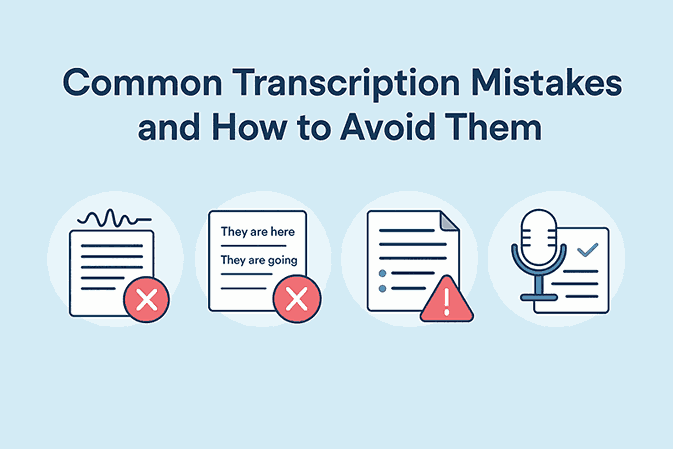
If you’ve ever transcribed an interview or meeting, you know how hard it is.
Distorted audio.
Fast speakers.
Background noise.
You replay again and again.
Hours later, your document has gaps and errors. These mistakes waste time and can hurt your reputation.
Think of a journalist misquoting or a doctor recording the wrong dose. It happens often. Most guides only say “proofread”, without real solutions.
This one’s different.
Here you’ll get:
Real example
Reasons these problems happen
Clear steps to fix them
Answers to common questions
If you’re tired of frustration, you’re in the right place
Why Transcription Errors Arise
The majority of people think transcription is just typing what is being heard. However, it is a step-by-step process of listening, interpreting, formatting, and editing simultaneously.
This is why mistakes happen in spite of experienced staff.
Below are the most common reasons:
- Audio Issues: Warbled playback, noise in the background, and speech interference can render it almost impossible to actually hear everything.
- Cognitive Overload: Mental resources are expended typing and processing speech and there is information lost.
- New Words: Brand names, technical words, and acronyms get misheard.
- Inconsistent Style: Lacking a proper format convention, your essay is unstructured.
- Time Pressure: Rushing results in word omissions and bad grammar.
- Skipped Review: Errors due to overconfidence go undetected.
While competitors may vaguely refer to these issues, few acknowledge that such challenges are intrinsic to the transcription process — not just a result of post-editing negligence.
That’s why choosing an accurate voice to text platform like VoiceToNotes is essential. It’s designed to reduce errors from the start by combining AI precision with usability and data security.
The Real Costs of Transcription Errors
These errors are not mere minor irritants. They create monumental issues in industries:
Lost Time: Revising a cluttered transcript may take more time than beginning again.
Miscommunication: A single error can distort meaning and mislead your readers.
Reputation Damage: Poor, sloppy transcripts reflect poorly.
Legal Risks: Transcription mistakes in medical and legal professions may lead to issues of compliance, financial penalties, or even lawsuits.
Frustration: Redoing transcripts over and over is discouraging and energy-sapping.
For those looking to avoid these costly mistakes, this online transcription guide offers step-by-step instructions to help you transcribe voice memos accurately, efficiently, and securely.
Real-Life Example:
A physician's orders were once miswritten by a medical assistant who wrote "known drug allergies" as opposed to "no known drug allergies".
That slight mistake nearly resulted in the patient's denial of a life-saving medication.
It's a clear reminder that accuracy matters—more so than we might think.
The Most Common Transcription Errors
Here are the mistakes you'll see most often—along with examples so you can recognise them in your own writing.
1. Misheard Words
Example:
The speaker says "public relations", but you can hear and capture "public rotations".
Why It Happens:
Distorted sound quality
Unfamiliar words
Rapid speech or tachyphasia
Impact:
Misheard words will completely turn the meaning of a sentence around.
2. Grammatical and spelling mistakes
Example:
They are here at the conference.
They are going to the conference.
Why It Happens:
- Faster typing without paraphrasing
- Relying on spellcheck
- Fatigue and distraction
Impact:
Grammar mistakes decrease the readability and make you sound less professional.
3. Formatting Inconsistency
Example:
They apply number lists and bullets, and the treatment of headings also differs in the paper.
Why It Happens:
- No style manual to follow
- Copy and paste from different documents
Impact:
Unformatted transcripts are not readable.
4. Omissions and Omitted Words
Example:
One sentence missing because the speaker was not loud enough or was mumbling.
Why It Happens:
- Rushing
- Being distracted
- Not rehearsing difficult sections
Impact:
Partial transcript is not reliable and incomplete.
5. Typo errors
Example:
Typing "2022" instead of "2025," or "manger" instead of "manager.".
Why It Happens:
- Typing too quickly
- Not reading it word by word
Impact:
Small typos lead to enormous misunderstandings.
6. Misidentifying Speakers
Example:
Telling something to the incorrect member of a meeting. Why It Happens:
- No assigned speaker tags
- Concurrent speech
Impact:
Speaker confusion undermines the validity of the entire transcript.
7. Ignoring Context
Example:
Translating "BP" into "before present" when the speaker intended "blood pressure".
Why It Happens
- Lack of background research
- Assumptions of meaning
Impact: Misinterpretation of context results in false or inaccurate reporting.
8. Running without looking
Example:
Uploading the transcript immediately upon finalisation without editing.
Why it Happens
- Strict deadlines
- Overconfidence
Impact: Unchecked transcripts always have hidden errors.
How to Prevent Transcription Errors
Far more than a rough outline, this is a simple template that you can adapt.
Step 1: Start with High-Quality Audio
- Employ a good-quality microphone and a soundproof room.
- Don’t record in echoey spaces, and ensure your speakers are speaking clearly and directly.
(You can explore more practical voice to notes tips to improve your audio recordings and transcription quality.)
Step 2: Get to know the material
- Listen to everything through before you start.
- Emphasise all the technical terms or names.
- Purchase something new.
Why It Matters: Contextual information before typing prevents most mistakes.
Step 3: Create a Style Guide
Decide in advance:
- How you decide speakers
- How to write headings and lists
- What punctuation rules do you observe
Why Most Get It Wrong: Most guides won't say that standard formatting is the one that introduces clarity.
Step 4: Transcribe in Sections
- Divide the audio into two short segments.
- Work on each section independently.
- Take breaks and rest to prevent exhaustion.
Step 5: In-depth Proofreading Read it out loud.
- Use spell and grammar check.
- Verify timestamps and speaker tags.
- Try line-by-line reading.
Step 6: Leverage AI Tools
AI transcription model-based software increases your productivity and workflow.
Learn more about How AI transcription actually works to understand why its accuracy is more than manual typing
FAQ
**Q. What are transcriptional error types? **
A. Misheard words, grammatical errors, omissions, improper formatting, and improper speaker identification are all included.
**Q. How can I prevent transcription errors? **
A. Use sounds that are easy to hear, get used to information, develop a style guide, work slowly, and proofread carefully.
**Q. What are some possible transcriptional errors? **
A. Deep context misunderstandings, especially in health and legal settings, are all common errors ranging from typos to input omissions.
Writing "known drug allergies" instead of "no known drug allergies" on patient charts—a dangerous habit for patients—is a transcription error.
**Q. Do you do it by hand or by computer program? **
A. Although software is quicker, human verification is required for precision and fit.
Conclusion
Every Time Getting It Right at the same time, listening, analyzing, formatting, and editing; transcription is not typing. That's why errors occur more than they should.
With the right plan—clear audio, preparation, efficient processes, and careful listening—you can easily make your transcripts more accurate and reliable. There is something for you if you're willing to make transcription easier without sacrificing quality.
Try VoiceToNotes.ai today and see how easy professional-grade transcription can be if you need to make quick and accurate transcripts.
